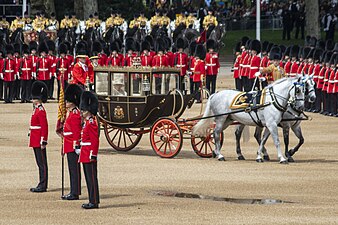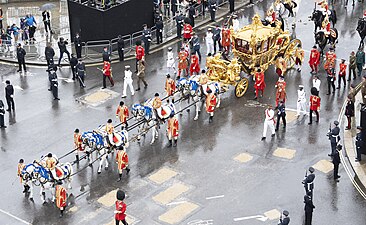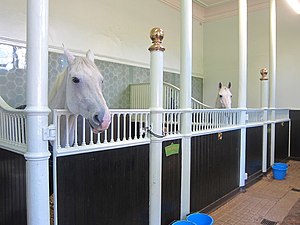
Buckingham Palace is a royal residence in London, and the administrative headquarters of the monarch of the United Kingdom. Located in the City of Westminster, the palace is often at the centre of state occasions and royal hospitality. It has been a focal point for the British people at times of national rejoicing and mourning.
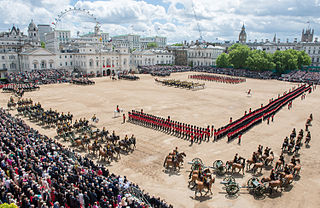
Trooping the Colour is a ceremonial event performed every year on Horse Guards Parade in London, United Kingdom, by regiments of Household Division, to celebrate the official birthday of the British sovereign. It is also known as the Sovereign's Birthday Parade. Similar events are held in other countries of the Commonwealth. In the UK, it is, with the State Opening of Parliament, the biggest event of the ceremonial calendar, and watched by millions on TV and on the streets of London.
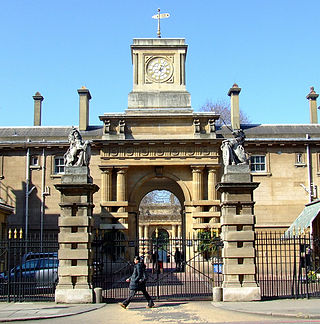
The Royal Mews is a mews, or collection of equestrian stables, of the British royal family. In London these stables and stable-hands' quarters have occupied two main sites in turn, being located at first on the north side of Charing Cross, and then within the grounds of Buckingham Palace.
The Household Cavalry (HCAV) is a corps of the Household Division that is made up of the two most senior regiments of the British Army – The Life Guards and The Blues and Royals. They have taken part in every major conflict since 1660. These regiments are divided between the Household Cavalry Regiment stationed at Wing Barracks in Wiltshire, with an armored reconnaissance role, and the ceremonial mounted unit, the Household Cavalry Mounted Regiment, garrisoned at Hyde Park Barracks in London. Both the HCMR and HCR are made up of elements of the Life Guards and the Blues and Royals. The Household Cavalry is part of the Household Division and is the King's official bodyguard. Although the Household Cavalry Regiment is armoured, it is not part of the Royal Armoured Corps, being assigned to the Household Division.
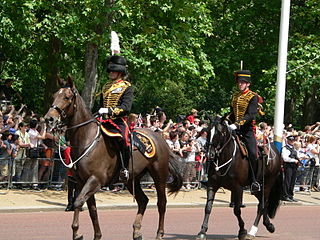
The King's Troop, Royal Horse Artillery, is a ceremonial unit of the British Army, quartered at Woolwich. It is a mounted unit and all of its soldiers are trained to care for and drive teams of six horses, each team pulling a First World War-era QF 13-pounder gun; six teams are used in the unit's Musical Drive. The Troop's duties include firing salutes on royal and state occasions, participation in parades, and the duties of the King's Life Guard at Horse Guards for one month each year. The unit provides the gun carriage and team of black horses for state funerals. The unit is most often seen providing gun salutes on state occasions in Hyde Park, and Green Park.

The Cleveland Bay is a breed of horse that originated in England during the 17th century, named after its colouring and the Cleveland district of Yorkshire. It is a well-muscled horse, with legs that are strong but short in relation to the body. The horses are always bay in colour, although a few light hairs in the mane and tail are characteristic of some breed lines. It is the oldest established horse breed in England. The ancestors of the breed were developed during the Middle Ages for use as pack horses, when they gained their nickname of "Chapman Horses". These pack horses were cross-bred with Andalusian and Barb blood, and later with Arabians and Thoroughbreds, to create the Cleveland Bay of today. Over the years, the breed became lighter in frame as they were employed more as carriage and riding horses. The popularity of the Cleveland Bay has greatly fluctuated since it was first imported to the United States in the early nineteenth century. Despite serious declines in the population after the Second World War, the breed has experienced a resurgence in popularity since the 1970s, although only around 550 horses existed worldwide as of 2006.

The Irish State Coach is an enclosed, four-horse-drawn carriage used by the British Royal Family. It is the traditional horse-drawn coach in which the British monarch travels from Buckingham Palace to the Palace of Westminster to formally open the new legislative session of the UK Parliament.

The Gold State Coach is an enclosed, eight-horse-drawn carriage used by the British royal family. Commissioned in 1760 by Francis Rawdon-Hastings, 1st Marquess of Hastings for King George III, and designed by Sir William Chambers, it was built in the London workshops of Samuel Butler. It was commissioned for £7,562. It was built for George III's coronation in 1761, but was not ready in time; it was completed in 1762.
The Household Cavalry Mounted Regiment (HCMR) is a cavalry regiment of the British Army tasked primarily with ceremonial duties. Part of the Household Division, it is classed as a regiment of guards, and carries out mounted ceremonial duties on State and Royal occasions. The HCMR is one of two operational units that form the Household Cavalry (HCav), the other being the Household Cavalry Regiment (HCR), a formation reconnaissance regiment, with front-line combat duties.

The Scottish State Coach is an enclosed, four-horse-drawn carriage used by the British Royal Family.

A landau is a four-wheeled carriage with a cover that can be let down. It was a luxury carriage. The low shell of the landau provides maximal visibility of the occupants and their clothing, a feature that makes a landau a popular choice for ceremonial occasions.

James Alexander Philip Theo Mountbatten-Windsor, Earl of Wessex, styled Viscount Severn from 2007 until 2023, is the younger child and son of Prince Edward, Duke of Edinburgh, and Sophie, Duchess of Edinburgh. He is the youngest nephew of King Charles III. He was born during the reign of his paternal grandmother Elizabeth II, at which time he was 8th in line to the British throne. He is currently 15th.

The Australian State Coach is an enclosed, six horse-drawn coach used by the British royal family. Constructed in 1986-88, it was the first royal state coach to have been built since 1902. It was presented to Queen Elizabeth II in Canberra on 8 May 1988, as the official gift on the occasion of the Australian Bicentennial, and was first used in November of that year by the Queen at the State Opening of Parliament in the UK.

The Diamond Jubilee State Coach is an enclosed, six-horse-drawn carriage that was made to commemorate Queen Elizabeth II's 80th birthday, but completion was delayed for nearly eight years. Eventually, it became a commemoration for the Queen's Diamond Jubilee.

In the United Kingdom, state funerals are usually reserved for monarchs. The most recent was the state funeral of Queen Elizabeth II on 19 September 2022.

The Speaker's State Coach, built in 1698, is the oldest of the state coaches of the United Kingdom. It is decorated with elaborate gilded carvings and allegorical paintings by Giovanni Cipriani. The coach was originally designed for King William III by Daniel Marot. Around 1702, William's successor, Queen Anne, gifted it to the Speaker of the House of Commons. It has been used in processions on state occasions such as coronations and jubilees, when the Speaker would ride the short journey from the Palace of Westminster to Westminster Abbey before the service, and then in the carriage procession following the service. The coach was retired from use in 2005, extensively restored, and remains on display for the public as a historical work of art with the Parliamentary Art Collection.

The United Kingdom's 1902 State Landau is a horse-drawn carriage with flexible leather hoods which drop.

The Glass Coach is one of the principal State carriages of the British monarch. Built by Peters & Sons of London in 1881, it had originally been designed as a sheriff's coach, but was purchased by the Crown in time for the coronation of George V in 1911.

The coronation of George V and his wife, Mary, as king and queen of the United Kingdom and the British Dominions took place at Westminster Abbey, London, on Thursday 22 June 1911. This was the second of four such events held during the 20th century and the last to be attended by royal representatives of the great continental European empires.

The 2023 Trooping the Colour was held on 17 June 2023. Over 1,500 soldiers, 300 horses, and 400 musicians took part in the ceremony, the first to be held during King Charles III's reign, and for his first Official Birthday.

